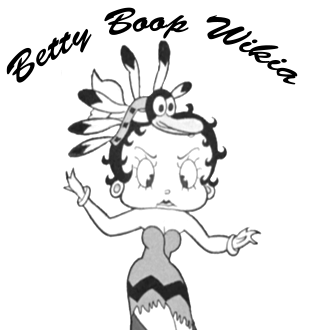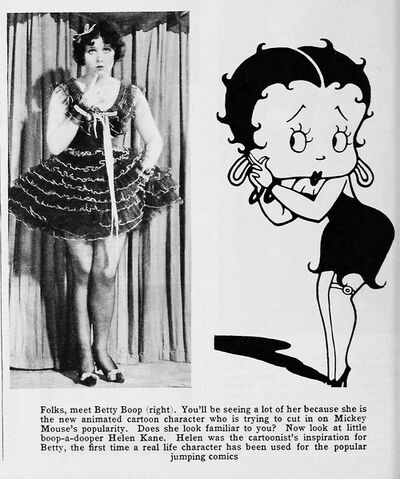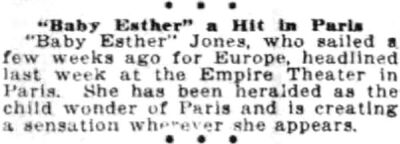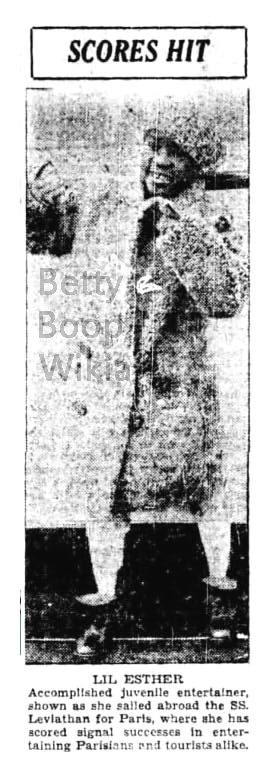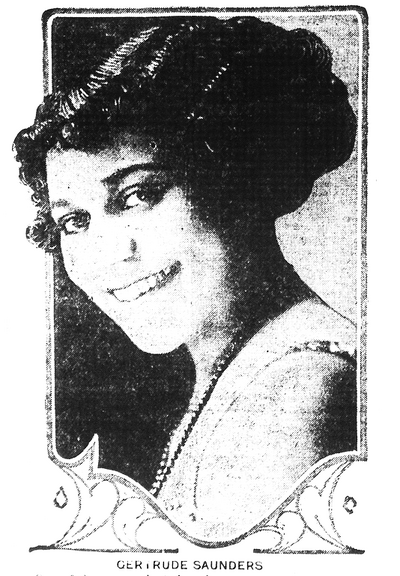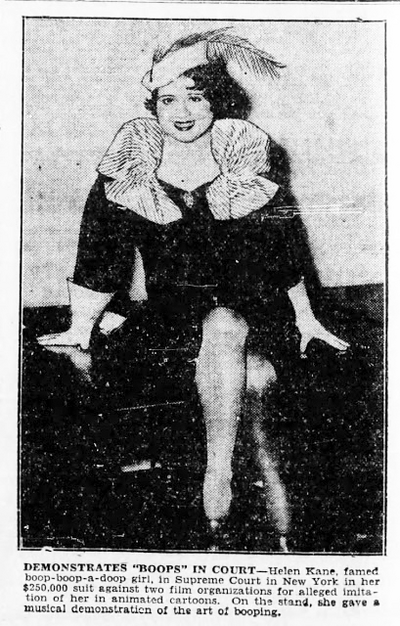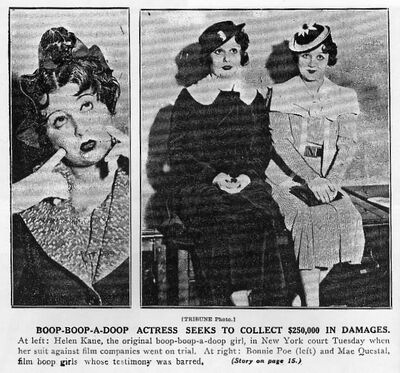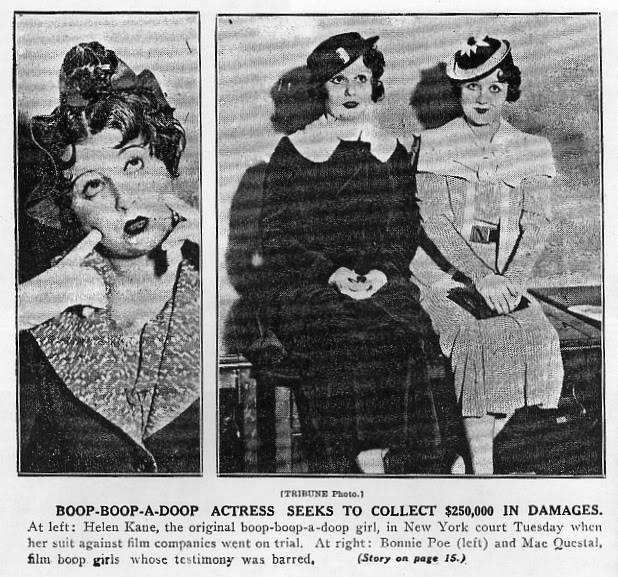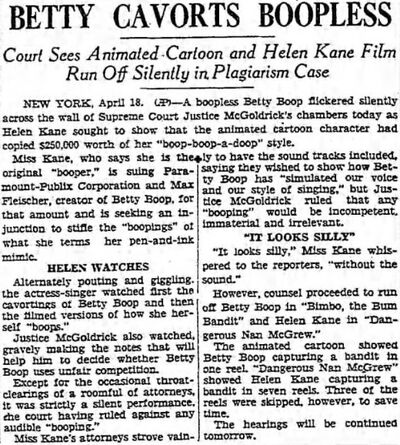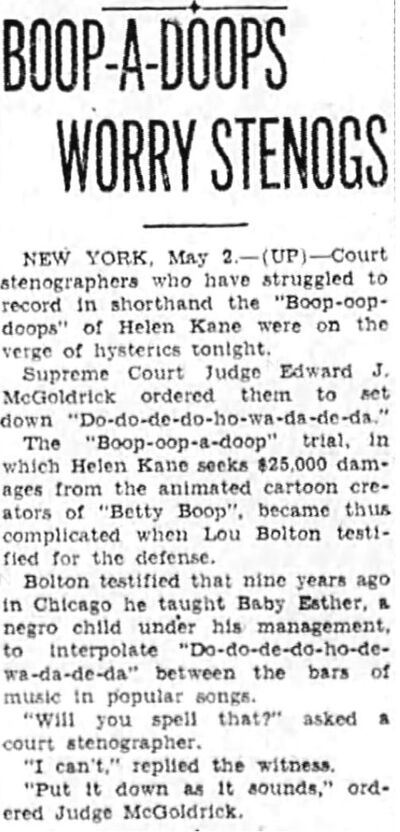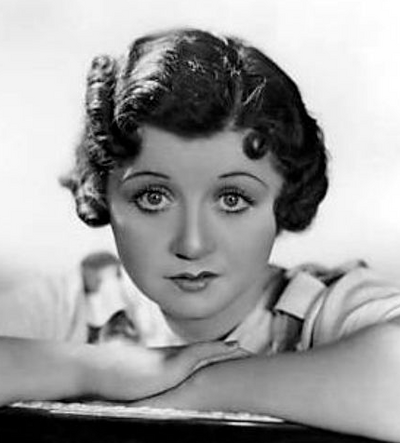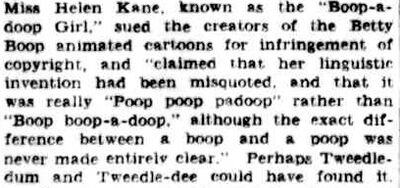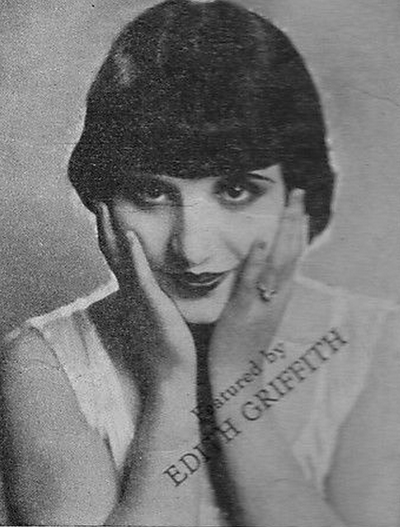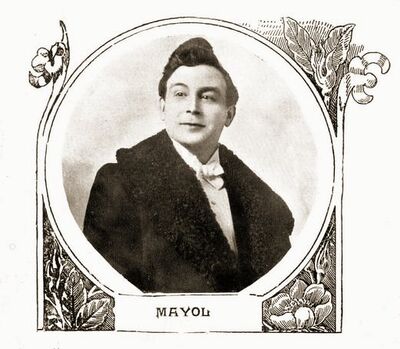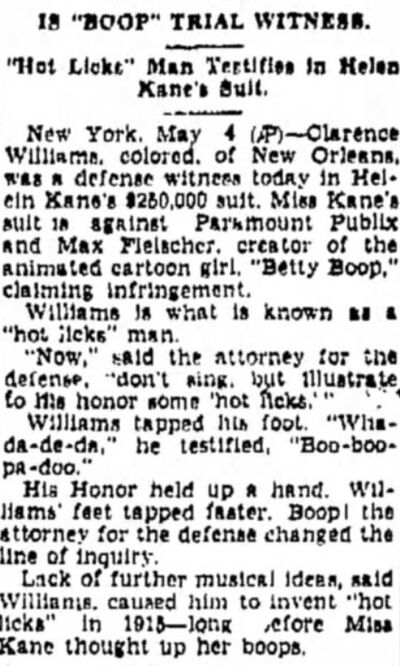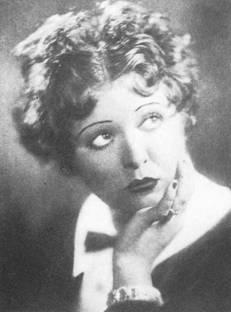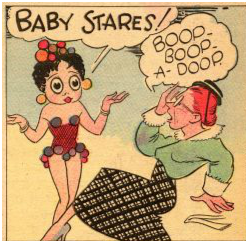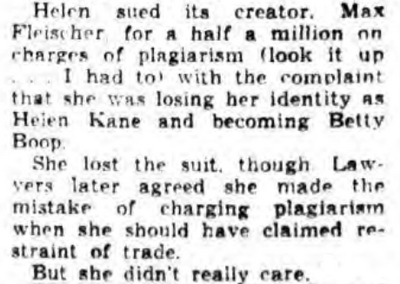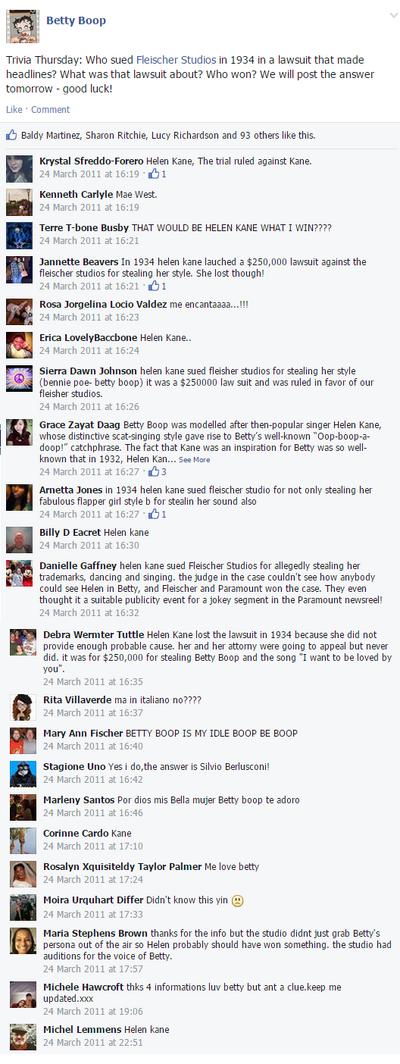| $250,000 Lawsuit | |
|---|---|
 | |
|
Name |
$250,000 Lawsuit |
In May 1932, Helen Kane filed a $250,000 infringement lawsuit against Max Fleischer and Paramount Publix Corporation for the deliberate caricature that produced unfair competition. While Kane had risen to fame in the late 1920s as "The Boop-Oop-A-Doop Girl," a star of stage, recordings, and films for Paramount, her career was nearing its end by 1931. Paramount promoted the development of Betty Boop following Kane's decline. The case was brought in New York in 1934. Although Kane's claims seemed to be valid on the surface, it was proven that her appearance was not unique. Both Kane and the Betty Boop character bore resemblance to Paramount top-star Clara Bow On April 19, Fleischer testified that Betty Boop purely was a product of the imaginations of himself and detailed by members of his staff. Little Ann Little, Mae Questel, Margie Hines and Bonnie Poe were all summoned to testify.
Fleischer V Kane
"The plaintiff seeks to prevent the defendants from using and exploiting pictorial representations and portrayals of her and to prevent the defendants from using and exploiting her professional, theatrical name, in violation of Sections 50 and 51 of the Civil Rights Law; and the plaintif seeks to prevent the defendants from deceiving the public into the belief that the performances of the cartoon character Betty Boop are the performances of the plaintiff, and from deceiving the public into the belief that the plaintiff actually supplied the singing and talking synchronized with the actions of the said cartoon character in the Betty Boop cartoons. Plantiff originates and still uses a method of singing songs consisting of the interpolation at frequent intervals of the sounds Boop-Boop-a-Doop, or Boop-Boopa-Doop or Boop-Boop-Pa-Do or Boopa-Doop or simply Boop alone."
The most significant evidence against Kane's case was her claim as to the uniqueness of her singing style. Testimony revealed that Kane had witnessed an eight year old African-American performer Baby Esther Lee Jones, using a similar vocal style in an act at a nightclub some years earlier. Esther was a child wonder, who used to sing and dance in her acts who would later go on to tour several countries becoming a hit in Paris in 1929, creating a sensation wherever she appeared. In 1929 Baby Esther toured the world in a revue. According to Esther's ex-manager Lou Bolton, Kane had debuted her "Boop-Boop-a-Doop" in Summer 1928, whereas Esther had delivered many Boops months before her. He also claimed that Helen had a ring side seat at the Everglades Club on Broadway one Winter's night when Baby Esther was Booping.
An early test sound film was also discovered, which featured Baby Esther (originally billed Lil Esther) performing in this style, disproving Kane's claims. Baby Esther's handlers were later brought back into court and were fined for having an underage child work at nightclubs. Supreme Court Judge "Edward J. McGoldrick" ruled: "The plaintiff has failed to sustain either cause of action by proof of sufficient probative force." In his opinion, the baby technique of singing did not originate with Kane. According to Leslie Cabarga (Who had met Mae Questel in person), Helen Kane went to Max Fleischer and said if you use me in the cartoons instead of the other girl (Mae Questel) I'll drop the suit. Max who knew Mae Questel said I won't use anyone but my Mae.
When African-American singer, actress, dancer and comedian Gertrude Saunders caught wind of the trial, she later came out as the true originator of "Boop-Boop-a-Doop". She stated that she had Booped long before the animated cartoon character Betty Boop and Helen Kane in 1921, and had originated the style of singing when she used to appear in an all-black Broadway show in the early 1920s (Shuffle Along) where she ended with her number "Daddy Won't You Please Come Home," ending the entire scat chorus in baby talk. From 1934-1950, Saunders was tributed as the originator of Booping.
Betty Boop Vs Helen Kane
In court cartoons featuring Betty Boop were shown against Kane's film appearances. Dizzy Dishes (1930), Pointed Heels (1929), Boop-Oop-a-Doop (1932), Nothing But the Truth (1929), The Bum Bandit (1931), Dangerous Nan McGrew (1930) but with no sound. As the Judge was very strict in his ruling so Helen Kane was then asked to demonstrate her Boop technique in front of him.
Demonstrates "Boops" In Court - Helen Kane, famed Boop-Boop-a-Doop girl, in Supreme Court in New York in her $250,000 suit against two film organizations for alleged imitation of her in animated cartoons. On the stand, she gave a musical demonstration of the art of Booping. Max Fleischer was cross-examined by Samuel R Weltz, the counsel for Helen Kane.
Max Fleischer told of seeing Helen Kane at an entertainment given by the Paramount Company in 1928. Al-though a number of other actors appeared. Mr. Fleischer was unable to recall their names."Aren't you influenced by the people you meet in life when you create a cartoon character?" demanded Mr. Weltz. "Not exactly," said the witness. "Is the hairdress of Betty Boop one of the figments of your imagination" Mr. Fleischer replied in the afirmative, adding that in the production of the entire character he was assisted by members of his staff. Mr. Weltz, had previously called attention to the fact that both Betty Boop and Helen Kane parted their black hair in the center and that long split-curls adorn their fore-heads.
In court Max Fleischer was forced to admit that Helen's Booping had antedated Betty Boop's.
Betty Cavorts Boopless
Court sees animated cartoon and Helen Kane film run off silently in plagiarism case. A boopless Betty Boop flickered silently across the wall of Supreme Court Justice McGoldrick's chambers today as Helen Kane sought to show that the animated cartoon character had copied $250,000 worth of her "Bop-Boop-a-Doop" style. Miss Kane, who says she is the original "Booper" is suing Paramount-Publix Corporation and Max Fleischer, creator of Betty Boop for that amount and is seeking an injunction to stifle the "Boopings" of what she terms her pen and ink mimic. Helen watches - Alternately pouting and giggling, the actress - singer watched first the cavortings of Betty Boop and then the filmed versions of how she herself "Boops." Justice McGoldrick also watched, gravely making the notes that will help him to decide whether Betty Boop uses unfair competition. Except for the occasional throat-clearings of a roomful of attorneys, it was strictly a silent performance. The court having ruled against any audible "Booping." Miss Kane's attorneys strove vainly to have the sound tracks included, saying hey wished to show how Betty Boop has "simulated our voice and our style of singing," but Justice McGoldrick ruled that any "Booping" would be incompetent, immaterial and irrelevant. "It looks silly," Miss Kane whispered to the reporters, "without the sound." However, cousel proceeded to run off Betty Boop in "Bimbo, The Bum Bandit" and Helen Kane in Dangerous Nan McGrew. The animated cartoon showed Betty Boop capturing a bandit in one reel. "Dangerous Nan McGrew" showed Helen Kane capturing a bandit in seven reels. Three of the reels were skipped, however to save time.
Boop-A-Doops Worry Stenogs
Court stenographers who have struggled to record in shorthand the "Boop-Oop-a-Doops" of Helen Kane were on the verge of hysterics tonight.Supreme Court Judge Edward J. McGoldrick ordered them to act down "Do-Do-De-Do-Ho-Wa-De-Da." The "Boop-Oop-a-Doop" trial, in which Helen Kane seeks $250,000 damages from the animated cartoon creators of Betty Boop became thus complicated when Lou Bolton testified fr the defense. Bolton testified that nine years ago in Chicago he taught Baby Esther, a negro child under his management to interpolate "Do-Do-De-Do-Ho-De-Wa-Da-De-Da" between the bars of music in popular songs. "Will you spell that?" asked a court stenographer. "I can't," replied the witness. "Put it down as it sounds," ordered Judge McGoldrick.
Mae Questel Grilled In Court
Mae Questel who was the official voice of Betty Boop at the time was grilled by Helen Kane's defense. Hines the original voice of Betty Boop & Poe were also questioned. Questel was asked what song she had performed at the Helen Kane contest. Questel stated she had sung "He's So Unusual" and had won first place. She was asked if she used to mimic Helen Kane and she admitted that she did at the Fordham Theatre along many other girls. She was asked if she was advertised after winning the show and she said yes and went on to perform "He's So Unusual" at the Riverside Theatre. She was asked if she knew Bonnie Poe and asked why Poe had her hair combed like Miss Kane. Questel stated that they always wore curls in their hair. She was then asked if she knew that Helen Kane was the Boop-Boop-a-Doop girl. When asked about singing "That's My Weakness Now" in the 1932 cartoon entitled Stopping the Show Questel stated she did not mimic Helen Kane but had been to about 4-5 shows at theatres where she watched Kane perform publicly. According to Questel she was touring at the time of the lawsuit as Mae Betty Boop Questel singing Betty Boop songs from the cartoon series. But did not associate her Betty Boop singing voice with Kane through each and every question answered.
Poop Poop Padoop?
According to Helen Kane her original scat lyrics were not "Boop Boop a Doop", they were originally "Poop Poop Padoop". Helen Kane claimed that her linguistic invention had been misquoted and that it was really "Poop Poop Padoop" rather than "Boop Boop a Doop". Although the exact difference between a Boop and a Poop was never made entirely clear. It has been indicated that Helen's scat sounds were influenced by other performers and that she had adapted the scat sounds she had heard and made them her own.
Edith Griffith
Edith Griffith was also used as evidence as "Booping" in a early recording alongside Baby Esther.
Several other baby singers were also used against Kane. Nan Halperin, Irene Franklin, Peggy Bernier, Duncan Sisters, Hannah Williams.
Felix Mayol
Felix Mayol was also used as evidence as "Booping" in the 1913 song entitled Bou Dou Ba Boum (1913) Helen responded to this by saying she had never heard of the song.
Clarence Williams
Clarence Williams a African-American music publisher and composer testified at the $250,000 lawsuit of Helen (Boop-a-Doop) Kane told the Supreme Court Justice McGoldrick in Manhattan that back in 1915 he invented “Hot Licks" Which went mostly “What-Da-De-Da” with an occasional "Boop" thrown in by accident. The witness said he had invented the “Hot Licks” when he ran out of words and music. When Margie Hines was summoned to testify in court she also called the Boop sounds she had made "licks".
Hot Licks Man Testifies In Helen Kane Suit
Clarence Williams, colored of New Orleans was a defense witness today in Helen Kane's $250,000 suit. Miss Kane's suit is against Paramount Publix and Max Fleischer, creator of animated cartoon girl Betty Boop claiming infringement. Williams is what is known as a "hot licks" man. Now, said the attorney for the defense, don't sing but illustrate to his honor some "hot licks", Williams tapped his foot, "Wha-Da-De-Da", he testified, "Boo-Boo-Pa-Doo." His honor held up a hand. Williams feet tapped faster. Boop! the attorney for the defense changed the line of inquiry. Lack of further musical ideas said Williams, caused him to invent "hot licks" in 1913 - long before Miss Kane thought up her Boops.
Max Fleischer Denies Lifting Helen Kane's Stage Act
Says "Betty Boop" product of imaginations of him-self and staff. The great "Boop-Boop-a-Doop" trial went booping along in supreme court today with artist Max Fleischer denying he used Helen Kane as an unwitting model for his animated Betty Boop cartoons. Betty Boop, Fleischer testifed is purely a product of the imaginations of himself and his staff. Miss Kane, who claims to have originated the idea of intersperging a catchy little "Boop-Boop-a-Doop" now and then when singing a song is seeking $250,000 damages from Fleischer, the Fleischer Studios Inc, and Paramount Publix Corporation on the ground the Betty Boop cartoons are based on her personality and style of singing. Asked if he has ever seen Miss Kane perform before he began drawing Betty Boop cartoons in 1930, Fleischer recalled an entertainment at which she sang in 1928, her numbers were rewarded by "great applause", he added. "Aren't you influenced," Miss Kane's lawyer asked", by the people you meet-in life when you create a cartoon character?" "Not exactly,"replied Fleischer." Is the hairdress of Betty Boop one of the figments of your imagination?" "Yes" said the artist. The attorney previously had observed that Betty Boop and Miss Kane affected similar coiffures. "When you saw Miss Kane in 1928, he pursued "did you look at her nonchalantly or studiously?" Defense counsel objected and Justice McGoldrick told Fleischer he need not answer. In creating Betty Boop, the cartoonist said his principal contributions had been the rolling eyes and mature figure. Miss Kane who says she has been "Booping" since 1920 listened closely to Fleischer's testimony. She wore a flaming red hat with a long brown feather that has a habit of tickling her attorney's ear when he bent over to confer with her.
Dave Fleischer
The trial centered on who had coined the "Boop Oop a Doop" phrase. Dave Fleischer later recalled, "In the courtroom...we were all talking "Boops" and "Boop-Boop-Ba-Doops" and "Boopety Boop-Boops", and we'd say, 'It's not a "Boop", it's a "Boopety-Boop."
Resemblance
Mae Questel, Betty's voice was not the only one who looked like Betty Boop. The popular singer Helen Kane looked like her too. But then so did the movie star Clara Bow, the "It" girl. And so did thousands of other women. The boyish bob and split curls, round face, wide mascaraed eyes was very popular in the late 1920s and the 1930s.
According to Helen Kane
According to Helen Kane, the problem was not that she looked like Betty Boop but that Betty Boop looked like her and sang like her and most important, used the phrase "Boop-Oop-a-Doop", which Kane claimed to have invented. Although Kane's accusations strangely mirrored the cartoon, Max Fleischer remained undaunted by her claims that they had taken her "Boop-Oop-a-Doop".
Information on Helen Kane
In 1923, a plump, impudent artfully infantile young woman named Helen Kane began to appear in Vaudeville. In her songs she usually replaced the lyrics with extraordinary noises. Presently her favorite noise, "Boop-Boop-a-Doop," became a recognized word in Vaudeville's nonsense language. By 1928, Helen Kane had innumerable imitators. In 1931, there appeared in animated cinema cartoons a character called Betty Boop. Helen Kane grew fatter. Her infantilism grew less appropriate and profitable. Betty Boop remained babyish, alert, and so prosperous that her name became almost as familiar in Manhattan courtrooms as that of Ella Wendel. Producer Max Fleischer whose firm made the Betty Boop cartoons, distributed them through Paramount, successfully sued a doll manufacturer for imitating Betty Boop. It was Producer Fleischer and Paramount Publix Corp. who were sued by Helen Kane for $250,000 for copying her voice and mannerisms. Justice Edward J. McGoldrick ruled against a jury. Counsel ordered Helen Kane to remove her coat, arrange her hair like Betty Boop. Defendant Fleischer produced three baby faced young women who do the singing for Betty Boop cartoons. The court was darkened and three Betty Boop cartoons and one reel of a Helen Kane picture were projected on the wall. After this, Justice McGoldrick ruled that he had, had enough, demanded records and music sung by Helen Kane and Betty Boop before he made a decision. Grown fatter but still talking with the voice of an indignant doll.
Court Solemn as Helen Kane Boops Out Grief
The trial itself, although deadly serious for the principals, involved seems to have had been a sort of comic opera. The newpapers had a ball with it. Even the staid New York Times carried the headline that had read: "Court Solemn as Helen Kane Boops out Grief." At one point in the trial, the Times reported, Kane's lawyer directed her to remove her hat and coat, so the court might see if her face and figure resembled that of Betty Boop's. To make the resemblance more striking she arranged locks of her hair across her temples and cheeks. Young women in the audience immediately began practicing the coiffure. The same article also contained ectastic descriptions of her, were introduced. Justice McGoldrick remarked. "Of course, I shall consider only the pictures, but I suppose counsel will have no objection if I try the music on the piano, He said he would have no difficulty condidering the pictures alone, because they were obviously the prettiest parts of the sheets. "Thank you", piped Miss Kane.
Grim Natwick on the Creation of Betty Boop
According to animator Grim Natwick, it was he who created and designed the character while working on the Talkartoons. "Once morning they put on my desk a copy of the "Boop-Oop-a-Doop" song sung by Helen Kane, he told John Canemaker. At that time there were no designers and no story men. We virtually wrote our own stories and designed our own characters, then animated them, and so it was with Betty. I'm not even sure she was okayed before I animated her. Helen Kane was then working for Paramount at its studio in Astoria. Paramount had already sent the Fleischers another of its stars,Rudy Vallée (a service it would continue in the future), so the interest in Kane is not suprising. What is unusual is that Fleischer proceeded to copy Kane's distinctive look and sound without bothering to get her permission first. Despite the obvious connections and Natwick's later admission, Helen Kane lost her lawsuit when it was revealed that she was not the first "Boop-Oop-a-Doop" singer in the business. In final irony fans now associate this performance style with Mae Questel, who voiced most of the Betty Boop cartoons.
Raymond Pointer on the Lawsuit
According to Ray Pointer (Fleischer Historian) the early sound test of Baby Esther did not break at the point of the Boop sequence, but a reference to Helen Kane was removed from the 1932 cartoon "Stopping the Show", before being shown to the Judge and no longer appears in the episode.
Ray Pointer:
Information provided by Ray Pointer (Fleischer Historian): The film of "Baby" Esther was a double system sound technique like Vitaphone. Lou Fleischer told me the whole story. The film did not "break" at the point of the Boop-Oop-a-Doop part. They did not show this in court. What happened was the print has been spliced in several places due to breakage and went out of sync at the crucial point due to the lost frames. Lou and Kitty Pfister, head Film Cutter stayed up all night locating spots to insert black film slugs to replace the lost frames to put the crucial spot back in sync. A new married print with optical sound was produced, the Paramount News Lab being kept open all night waiting for this to present as evidence the next morning. The remark about Justice McGoldrick being "bribed" is a conclusion not based on fact. There was enough remaining evidence to prove Miss Kane's case. However since there is a Film Faily Trade Ad that places a picture of Helen Kane next to an early version of Betty Boop. Further evidence can be found in the tampering with the original negative to "Stopping the Show", which was built around Mae Questel's stage act impressions, which prompted Max Fleischer in hiring her. This is the first official Betty Boop cartoon which consists of a series of contemporary celebrities. Each is introduced by a photograph of that celebrity with animated lips and the voice of that celebrity coming from the picture. Only the voice of Maurice Chevalier is authentic. The voice of Fanny Brice is an imitation by Mae Questel. Oddly, the sequence begins with Betty going right into "That's My Weakness Now", a song made popular by Helen Kane. This song is not set up by the celebrity picture on the easel as the others are. You hear an audio splice from the audience applause going to the song. At two points there is a Long Shot, one of which Pans from the stage to the audience. In the background is an image on a easel that looks like the image of Helen Kane. Why else would it be there? This direct reference to Helen Kane was deliberately removed from the negative so that a new print could be shown in court that would not indicate an edit. But it clearly was removed from the negative. Paramount took advantage of the ignorance of film technology on the part of court, which accepted what they saw not knowing what had been done to alter the evidence.
Leslie Cabarga on the Lawsuit
According to Leslie Cabarga who had researched the Fleischer Studios stated that the Judge was in money's pocket.
Leslie Cabarga:
"I started to research and met Grim Natwick who is credited having created Betty Boop. I called him in California and he told me his story, which was that he had been given a sheet music of Helen Kane and they told him, hey, do a take off of her."
"What happened was err... Helen's lawyer kept bringing up these facts and he kept being overruled by a Judge that was brought by Paramount. So he, the "Judge" was in Paramount's pocket, he was in money's pocket. Which never happens to this day it never happens. So it was an anomaly then and unheard of now. The fairness of honesty and justice wins out all the time as we know in the American way but not back then. So every time Helen's lawyer would try to bring up an objection, state a fact he would be overruled. It became where he recognized how ridiculous this was and was almost kind of mocking it, saying I don't have a chance here. Apparently Helen Kane had gone to Max Fleischer and said if you use me in the cartoons, I'll drop suit, but Max said I won't use anyone but my Betty Boop (Mae Questel)."
Helen Kane Explained Her Difficulties
Helen Kane:
"I have become a ghost... Recently in Hollywood when some children ran to open the door of my car they greeted me as Betty Boop. Betty is just one stroke removed from Mickey Mouse."
Loser In Suit
Helen Kane who claims to be the original "Boop-Boop-a-Doop" stylist, is shown as she appeared in a New York City supreme courtroom where her $250,000 damage suit against Max Fleischer. She sought an injunction to stifle the movie "Boopings" of Betty Boop, pen and ink character which Fleischer contended was a product of his own imagination.
Verdict
Judge McGoldrick found that Helen Kane's singing style was most common to a number of Boop-a-Doopers even before Helen had claimed she had invented the idea and mannerisms. And the lawsuit ended with her losing against The Fleischer Studios and Paramount a company Helen herself used to be linked to in her earlier career.
Victory Newsreel
After winning the trial against Helen Kane, Max Fleischer accompanied by Mae Questel, Bonnie Poe, Margie Hines, Kate Wright and Ann Little performed a responce to Helen Kane in a Fleischer Victory Newsreel. Max stated that the five voices of Betty had something special in there voices. Mae Questel took the lead and performed "Don't take our Boop-Oop-a-Doop Away!". Five Voices of Betty Boop: "You can say our voices are awful, or my songs are too risqué, but don't take our "Boop-Oop-a-Doop Away!" the reason for this was, while in court Helen had ignored the voices of Betty Boop (Several of the women had entered Helen Kane contests and had won first place - according to information Helen had felt betrayed by the women who had won first place in her Helen Kane look and sound-alike contests held in the late 1920s) so Helen pretended they wasn't there and had basically saw them as nothing so this was their response to Helen after the trial had ended. The newspapers followed the lawsuit for days on end. And had given the character Betty Boop, her creator Max Fleischer and the voices of Betty Boop most of which who were uncredited for their role as Betty Boop in the cartoon series great publicity.
Helen Kane Mad! Mad! Mad!
After losing the trial against the Fleischer Studios Helen Kane denounced civilization incognito and then denounced civilization in the flesh. Miss Kane in fact didn't think the human race is being kind to her. gave a small interview in the papers where she let out her frustration on the Judge. "I want him to know that I'm not all Boop-Boop-a-Doop!" while appealing the case. She told her husband at the time that she never wanted to see another lawyer, newspaperman, Judge or courtroom in all her life. "I am MAD!, MAD!, MAD! I am so mad," she said, "I am going to spend a lot of money appealing this case. They have stolen my idea! I don't need money. I sued these Betty Boop people for $250,000, I don't want a cent of it. All I want is vindication. It has broken my heart." Helen Kane later decided to fight back with a cartoon caricature of herself dubbed "The Original Boop-Boop-a-Doop Girl" after hearing that Betty Boop would be given a comic strip so Helen contacted King Features in advance for a comic of her very own which was short lived and soon replaced by the Betty Boop comic strip.
In 1935 a year after the trial Helen Kane went on tour in Brooklyn. Her appearances featured Betty Boop as used in the posters and a Betty Boop cartoon. Max Fleischer was advised to sue but did not pursue Kane.
After Helen had lost the suit, lawyers agreed that Helen had made the mistake of charging plagiarism when she should have claimed re-straint of trade. Re-straint of trade is an action that interferes with free competition in a market, a clause in a contract that restricts a person's right to carry on their trade or profession.
Betty Boop was retired in 1939 and no longer appeared on screen. Helen Kane made a comeback in the 1950s and did TV appearances where she performed live and released several songs. One with MGM in 1954 entitled "The Boop Boop a Doop Girl". Helen also used to sign pictures of Betty Boop and hand them out, she was mistaken as the voice of Betty Boop. She died several years later in 1966 as she had battled breast cancer for more than a decade which later killed her. After she had died she was mistaken for the voice of Betty Boop in several newspapers. Betty Boop was later rediscovered in the 1970s but didn't quite make an impact until the 1980s where she became an iconic figure of the past.
Betty Boop References Lawsuit Several Years Later
On Betty Boop's old official website the Helen Kane V Fleischer Studios lawsuit was referenced and later removed. In 2011 on Betty Boop's official Facebook the lawsuit was referenced in a quiz which asked people "Who sued Fleischer Studios in 1934 in a lawsuit that made the headlines? What was the lawsuit about? Who won?" The quiz was left open and answered by fans.
Trivia
- Helen Kane told the court that Max Fleischer had seen her perform on stage at one of her shows.
- Dizzy Dishes and The Bum Bandit prove that Betty Boop was a caricature of Kane, although the Judge didn't think so.
- Helen Kane had played a Betty in the 1931 film Heads Up! the same exact year Betty Boop was given the name Betty. But according to the Fleischer Studios the animated character's name was inspired by the classic hit song "Betty Co-Ed".
- Helen wanted Betty Boop stopped by injunction.
- The lawsuit started in 1932 and ended in 1934.
- Mae Questel had won a Helen Kane look and sound-a-like contest when she was 17 years old, and was given a autograph by Kane stating "To Another Me". Mae then began a career impersonating stars from the 30s such as Marlene Dietrich, Fanny Brice, but was best known for her Kane impersonation.
- Margie Hines the original voice of Betty Boop had also had won a Helen Kane Boop-a-Doop contest in Brooklyn at the age of 17, and went on to do Betty's voice in the 1930 short Dizzy Dishes and continued to voice Betty in the early cartoons until 1932.
- Bonnie Poe and Mae Questel were hired as Helen Kane look and sound-alikes.
- Grim Natwick stated that he had used Kane's hair for the base of Betty Boop, where as in the court case Max Fleischer and his artist claimed that Betty's hair was styled after the "It" Girl Clara Bow & flappers of the 1920s.
- In the 1934 cartoon Poor Cinderella, Betty Boop's hair was turned red which resembled Clara Bow's, although Little Ann Little who was one of the several original voices of Betty Boop had red hair and "claimed" that Max Fleischer made Betty Boop's hair red because she had red hair.
- Baby Esther was presumed dead by her manager in 1934. In late 1934 a woman by the name of Gertrude Saunders came out to the papers and claimed she was the woman featured in the lawsuit.
- The newspapers followed the trial for days upon end which gave the voices of Betty Boop Bonnie Poe and Margie Hines publicity which then allowed Hines the original voice of Betty to snag a role alongside Harry Warren in 1933, and Bonnie Poe starred in Rambling Round Radio Row in 1934.
- Kate Wright and Ann Rothschild didn't appear in many of the newspaper photographs as they did the least voice-over for Betty Boop but they appeared in court and in the Victory Newsreel. Bonnie Poe, Margie Hines and Mae Questel were Betty's main voice actresses from 1930-1934.
- Sometimes it's claimed on official Betty Boop merchandise that; "Betty's body was designed after Mae West and that her singing voice was taken from Helen Kane" or "With a body like Marilyn Monroe and a singing voice like Helen Kane, on quite a few occasions Clara Bow is often mentioned.

